-
 KAIST Agrees to Cooperate with Three Hospitals in the Delivery of Emergency Medical Services
KAIST signed an agreement with three major hospitals in Korea, the National Police Hospital, Seoul National University Hospital in Bundang, and the Armed Forces Capital Hospital, to respond to national emergency situations such as the outbreak of epidemic diseases.
The signing ceremony for the agreement took place on July 27, 2015, at the JW Marriott Hotel in Seoul.
Under the agreement, the four institutions will cooperate in conducting research in basic medical science to develop treatments and vaccines, building a system to deliver emergency medical services including the establishment of preventive measures against epidemics, and providing emergency medical assistance to under-developed countries.
This agreement was initiated by the Institute of Disaster Studies at KAIST.
President Steve Kang of KAIST said, “Korean society has recently experienced the importance of building a network of medical intuitions and research universities to handle national emergency situations when Middle East Respiratory Syndrome hits the nation hard. We need to prepare for epidemics and biological disasters, and this agreement is the first step towards serving such need.”
From the left to the right in the picture are: President Hong-Soon Lee of the National Police Hospital, President Steve Kang of KAIST, President Myung-Chul Lee of the Armed Forces Capital Hospital, and President Ho-Sung Han of Seoul National University Hospital in Bundang.
2015.07.31 View 5733
KAIST Agrees to Cooperate with Three Hospitals in the Delivery of Emergency Medical Services
KAIST signed an agreement with three major hospitals in Korea, the National Police Hospital, Seoul National University Hospital in Bundang, and the Armed Forces Capital Hospital, to respond to national emergency situations such as the outbreak of epidemic diseases.
The signing ceremony for the agreement took place on July 27, 2015, at the JW Marriott Hotel in Seoul.
Under the agreement, the four institutions will cooperate in conducting research in basic medical science to develop treatments and vaccines, building a system to deliver emergency medical services including the establishment of preventive measures against epidemics, and providing emergency medical assistance to under-developed countries.
This agreement was initiated by the Institute of Disaster Studies at KAIST.
President Steve Kang of KAIST said, “Korean society has recently experienced the importance of building a network of medical intuitions and research universities to handle national emergency situations when Middle East Respiratory Syndrome hits the nation hard. We need to prepare for epidemics and biological disasters, and this agreement is the first step towards serving such need.”
From the left to the right in the picture are: President Hong-Soon Lee of the National Police Hospital, President Steve Kang of KAIST, President Myung-Chul Lee of the Armed Forces Capital Hospital, and President Ho-Sung Han of Seoul National University Hospital in Bundang.
2015.07.31 View 5733 -
 KAIST Operates a Summer School with Imperial College London
KAIST and Imperial College London jointly hosted a summer school on the KAIST campus on July 14-17, 2015. Twenty-five students from both universities, 11 from KAIST and 14 from Imperial College, participated in the summer program.
KAIST and Imperial College agreed to hold academic and research exchange programs in 2013; this year’s summer school represented the first effort.
Participants were divided into a few cohorts of four or five students. They conducted a series of activities to implement joint research projects involving team building, networking, joint study, discussions, and presentations.
Among the projects the summer school ran, Professor Hoi-Jun Yoo of the Electrical Engineering Department at KAIST was invited to teach students about the mobile healthcare system, Dr. M, that he had developed.
Sung-Hyon Myaeng, Associate Vice President of the International Affairs Office, KAIST, said, “This summer school is yet another example of KAIST’s ongoing efforts to make the campus more global and to interact actively with members of the international community.”
2015.07.29 View 9181
KAIST Operates a Summer School with Imperial College London
KAIST and Imperial College London jointly hosted a summer school on the KAIST campus on July 14-17, 2015. Twenty-five students from both universities, 11 from KAIST and 14 from Imperial College, participated in the summer program.
KAIST and Imperial College agreed to hold academic and research exchange programs in 2013; this year’s summer school represented the first effort.
Participants were divided into a few cohorts of four or five students. They conducted a series of activities to implement joint research projects involving team building, networking, joint study, discussions, and presentations.
Among the projects the summer school ran, Professor Hoi-Jun Yoo of the Electrical Engineering Department at KAIST was invited to teach students about the mobile healthcare system, Dr. M, that he had developed.
Sung-Hyon Myaeng, Associate Vice President of the International Affairs Office, KAIST, said, “This summer school is yet another example of KAIST’s ongoing efforts to make the campus more global and to interact actively with members of the international community.”
2015.07.29 View 9181 -
 International Undergraduate Conference ICISTS-KAIST 2015 and ICISTS-KAIST Public Colloquium Held on August 3, 2015 at KAIST
The ICISTS-KAIST 2015, an international conference organized by a student organization called the International Conference for the Integration of Science, Technology, and Society at KAIST, was held from August 3rd to 7th at the KAIST campus and ICC Hotel in Daejeon. This year’s conference theme was “Shaping the Future.” Over 300 undergraduate students from more than 20 countries joined the event. The conference offered opportunities to explore emerging issues in science and technology, particularly in the fields of robotics, medicine, and science communication.
Vitalic Buterin, a rising scientist who received the 2014 World Technology Award for his development of the Ethereum Project, and Alan Irwin, a renowned scholar in science communication at the Copenhagen Business School in Denmark, were invited as keynote speakers. The list of other speakers included Stefan Lorenz Sorgner, the Director and Co-founder of the Beyond Humanism Network; Wendell Wallach, a scholar at Yale University's Interdisciplinary Center for Bioethics; and Hideto Nakajima, a professor at the Department of History, Philosophy and Social Studies of Science and Technology at Tokyo Institute of Technology.
As part of the ICISTS-KAIST 2015, ICISTS also hosted a public colloquium on August 5, 2015 at the Science Hall in Daejeon National Science Museum. Ko San, the Director of TIDE Institute; Hyo-Joon Woo, the Chief Executive Officer of Fransen; and Dong-Il Jung, the Chief Executive Officer of iDrone participated as the speakers.
2015.07.29 View 8829
International Undergraduate Conference ICISTS-KAIST 2015 and ICISTS-KAIST Public Colloquium Held on August 3, 2015 at KAIST
The ICISTS-KAIST 2015, an international conference organized by a student organization called the International Conference for the Integration of Science, Technology, and Society at KAIST, was held from August 3rd to 7th at the KAIST campus and ICC Hotel in Daejeon. This year’s conference theme was “Shaping the Future.” Over 300 undergraduate students from more than 20 countries joined the event. The conference offered opportunities to explore emerging issues in science and technology, particularly in the fields of robotics, medicine, and science communication.
Vitalic Buterin, a rising scientist who received the 2014 World Technology Award for his development of the Ethereum Project, and Alan Irwin, a renowned scholar in science communication at the Copenhagen Business School in Denmark, were invited as keynote speakers. The list of other speakers included Stefan Lorenz Sorgner, the Director and Co-founder of the Beyond Humanism Network; Wendell Wallach, a scholar at Yale University's Interdisciplinary Center for Bioethics; and Hideto Nakajima, a professor at the Department of History, Philosophy and Social Studies of Science and Technology at Tokyo Institute of Technology.
As part of the ICISTS-KAIST 2015, ICISTS also hosted a public colloquium on August 5, 2015 at the Science Hall in Daejeon National Science Museum. Ko San, the Director of TIDE Institute; Hyo-Joon Woo, the Chief Executive Officer of Fransen; and Dong-Il Jung, the Chief Executive Officer of iDrone participated as the speakers.
2015.07.29 View 8829 -
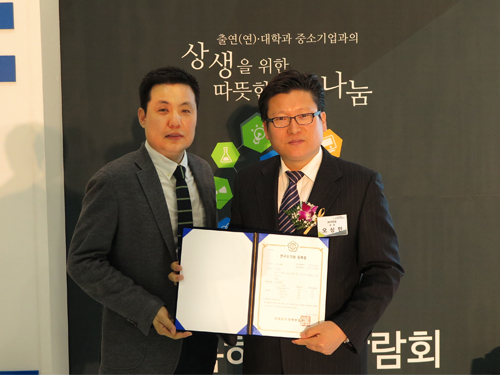 A Technology Holding Company Establishes Two Companies Based on Technologies Developed at KAIST
Mirae Holdings is a technology holding company created by four science and technology universities, KAIST, DIGIST (Daegu Gyeongbuk Institute of Science and Technology), GIST (Gwangju Institute of Science and Technology), and UNIST (Ulsan National Institute of Science and Technology) in 2014 to commercialize the universities’ research achievements. The company identifies promising technologies for commercialization, makes business plans, establishes venture capitals, and invests in startup companies.
Over the past year, Mirae Holdings has established two venture companies based on the technologies developed at KAIST. In September 2014, it founded Cresem Inc., a company used the anisotropic conductive film (ACF) bonding technology, which was developed by Professor Kyung-Wook Paik of the Material Science and Engineering Department at KAIST. Cresem provides a technology to bond electronic parts ultrasonically. The company is expected to have 860,000 USD worth of sales within the first year of its launching.
Last June, Mirae Holdings created another company, Doctor Kitchen, with the technology developed by Professor Gwan-Su Yi of the Bio and Brain Engineering Department at KAIST. Doctor Kitchen supplies precooked food, which helps diabetic patients regulate their diet. The company offers a personalized diet plan to customers so that they can effectively manage their disease and monitor their blood sugar level efficiently.
The Chief Executive Officer of Mirae Holdings, Young-Ho Kim, said, “We can assist KAIST researchers who aspire to create a company based on their research outcomes through various stages of startup services such as making business plans, securing venture capitals, and networking with existing businesses.”
Young-Ho Kim (left in the picture), the Chief Executive Officer of Mirae Holdings, holds a certificate of company registration with Sang-Min Oh (right in the picture), the Chief Executive Officer of Cresem.
Young-Ho Kim (left in the picture), the Chief Executive Officer of Mirae Holdings, holds a certificate of company registration with Jae-Yeun Park (right in the picture), the Chief Executive Officer of Dr. Kitchen.
2015.07.29 View 14607
A Technology Holding Company Establishes Two Companies Based on Technologies Developed at KAIST
Mirae Holdings is a technology holding company created by four science and technology universities, KAIST, DIGIST (Daegu Gyeongbuk Institute of Science and Technology), GIST (Gwangju Institute of Science and Technology), and UNIST (Ulsan National Institute of Science and Technology) in 2014 to commercialize the universities’ research achievements. The company identifies promising technologies for commercialization, makes business plans, establishes venture capitals, and invests in startup companies.
Over the past year, Mirae Holdings has established two venture companies based on the technologies developed at KAIST. In September 2014, it founded Cresem Inc., a company used the anisotropic conductive film (ACF) bonding technology, which was developed by Professor Kyung-Wook Paik of the Material Science and Engineering Department at KAIST. Cresem provides a technology to bond electronic parts ultrasonically. The company is expected to have 860,000 USD worth of sales within the first year of its launching.
Last June, Mirae Holdings created another company, Doctor Kitchen, with the technology developed by Professor Gwan-Su Yi of the Bio and Brain Engineering Department at KAIST. Doctor Kitchen supplies precooked food, which helps diabetic patients regulate their diet. The company offers a personalized diet plan to customers so that they can effectively manage their disease and monitor their blood sugar level efficiently.
The Chief Executive Officer of Mirae Holdings, Young-Ho Kim, said, “We can assist KAIST researchers who aspire to create a company based on their research outcomes through various stages of startup services such as making business plans, securing venture capitals, and networking with existing businesses.”
Young-Ho Kim (left in the picture), the Chief Executive Officer of Mirae Holdings, holds a certificate of company registration with Sang-Min Oh (right in the picture), the Chief Executive Officer of Cresem.
Young-Ho Kim (left in the picture), the Chief Executive Officer of Mirae Holdings, holds a certificate of company registration with Jae-Yeun Park (right in the picture), the Chief Executive Officer of Dr. Kitchen.
2015.07.29 View 14607 -
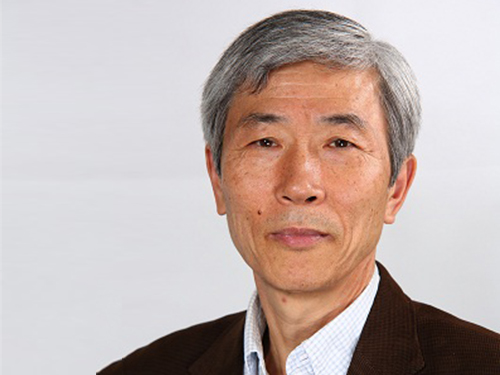 Professor Suk-Joong Kang Receives the Richard Brook and Helmholtz Awards
Professor Suk-Joong Kang of KAIST’s Department of Materials Sciences and Engineering received the Richard Brook Award from the European Ceramic Society at its 14th conference held on June 21, 2015, in Toledo, Spain. The award is presented to the most distinguished academic or engineer in ceramics from a non-European country. Professor Kang gave the commemorative lecture after the award ceremony.
Professor Kang is an expert in the field of sintering and microstructural evolution in ceramics and metals. He suggested a new model for grain growth and identified the principles of microstructural evolution.
He also received the 2015 Helmholtz Fellow Award in June. The Helmholtz Association, the largest scientific organization in Germany, confers the award on outstanding senior scientists based outside Germany who have made great academic and research achievements in their fields.
Professor Kang said of the Brook Award, “It is such an honor to receive an award from an eminent global institution. I take this opportunity to thank my students and colleagues for their support, and I will work harder for my research.”
2015.07.20 View 7533
Professor Suk-Joong Kang Receives the Richard Brook and Helmholtz Awards
Professor Suk-Joong Kang of KAIST’s Department of Materials Sciences and Engineering received the Richard Brook Award from the European Ceramic Society at its 14th conference held on June 21, 2015, in Toledo, Spain. The award is presented to the most distinguished academic or engineer in ceramics from a non-European country. Professor Kang gave the commemorative lecture after the award ceremony.
Professor Kang is an expert in the field of sintering and microstructural evolution in ceramics and metals. He suggested a new model for grain growth and identified the principles of microstructural evolution.
He also received the 2015 Helmholtz Fellow Award in June. The Helmholtz Association, the largest scientific organization in Germany, confers the award on outstanding senior scientists based outside Germany who have made great academic and research achievements in their fields.
Professor Kang said of the Brook Award, “It is such an honor to receive an award from an eminent global institution. I take this opportunity to thank my students and colleagues for their support, and I will work harder for my research.”
2015.07.20 View 7533 -
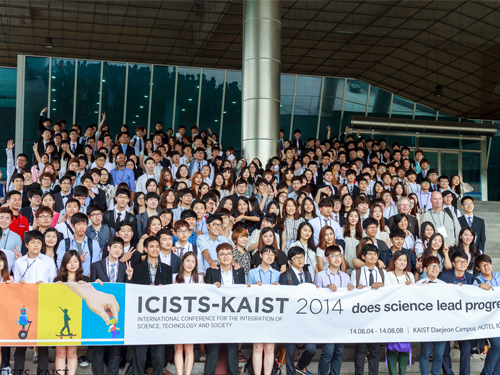 KAIST Undergraduates Organize the Largest Interdisciplinary Conference in Asia
The largest interdisciplinary conference in Asia hosted by KAIST undergraduates for students around the world will be held in KAIST. The organizing committee of International Conference for the Integration of Science, Technology and Society (ICISTS) will hold the ICISTS-KAIST 2015 in KAIST and Hotel ICC from August 3-7, 2015, with around 300 Korean and international participants.
ICISTS-KAIST was established in 2005 to provide an annual platform for students to discuss the integration and the convergence of science, technology and society, regardless of their academic background.
This year’s theme is "Shaping the Future" and the topics for the conference are robotics, medicine, and science communication.
The keynote speakers are Vitalic Buterin, the winner of the World Technology Award in 2014 for the co-creation and invention of Ethereum and Alan Irwin, a well-known scholar of science, technology and society as well as the Dean of Research at the Copenhagen Business School in Denmark.
Other notable speakers include Adam Marcus, a professor of Hematology and Medical Oncology, Emory University School of Medicine; Stefan Lorenz Sorgner, the Director and co-founder of Beyond Humanism Network; Hideto Nakajima, a professor in the Department of History, Philosophy and Social Studies of Science and Technology at Tokyo Institute of Technology; Wendell Wallach, a lecturer at the Yale University Interdisciplinary Center for Bioethics; Jinil Lee, a professor in the Division of Biological Science and Technology at Yonsei University; and Sangwook Kim, an editor of APCTP web journal Crossroads and a professor in the Department of Physics Education, Pusan National University.
Last year, more than 300 students from 50 different countries attended the ICISTS-KAIST 2014 as delegates to exchange their thoughts and ideas on science, technology, and society.
To register for the event, please visit www.icists.org.
2015.07.14 View 9521
KAIST Undergraduates Organize the Largest Interdisciplinary Conference in Asia
The largest interdisciplinary conference in Asia hosted by KAIST undergraduates for students around the world will be held in KAIST. The organizing committee of International Conference for the Integration of Science, Technology and Society (ICISTS) will hold the ICISTS-KAIST 2015 in KAIST and Hotel ICC from August 3-7, 2015, with around 300 Korean and international participants.
ICISTS-KAIST was established in 2005 to provide an annual platform for students to discuss the integration and the convergence of science, technology and society, regardless of their academic background.
This year’s theme is "Shaping the Future" and the topics for the conference are robotics, medicine, and science communication.
The keynote speakers are Vitalic Buterin, the winner of the World Technology Award in 2014 for the co-creation and invention of Ethereum and Alan Irwin, a well-known scholar of science, technology and society as well as the Dean of Research at the Copenhagen Business School in Denmark.
Other notable speakers include Adam Marcus, a professor of Hematology and Medical Oncology, Emory University School of Medicine; Stefan Lorenz Sorgner, the Director and co-founder of Beyond Humanism Network; Hideto Nakajima, a professor in the Department of History, Philosophy and Social Studies of Science and Technology at Tokyo Institute of Technology; Wendell Wallach, a lecturer at the Yale University Interdisciplinary Center for Bioethics; Jinil Lee, a professor in the Division of Biological Science and Technology at Yonsei University; and Sangwook Kim, an editor of APCTP web journal Crossroads and a professor in the Department of Physics Education, Pusan National University.
Last year, more than 300 students from 50 different countries attended the ICISTS-KAIST 2014 as delegates to exchange their thoughts and ideas on science, technology, and society.
To register for the event, please visit www.icists.org.
2015.07.14 View 9521 -
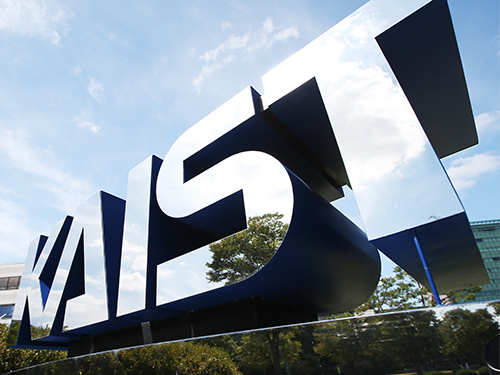 KAIST Startups Annually Engage 33,000 People, and Their Sales Total Nearly 10 Billion Dollars
According to a recent study, KAIST startups annually engage 33,000 people, and their sales total nearly 10 billion US dollars. Also amongst 1,245 companies, 50 were listed in stock markets including KOSDAQ and KONEX. President Kang of KAIST commissioned an evaluation of KAIST startups last year. The report consisted of six chapters: current status of entrepreneurs and companies, cross analysis based on individuals’ background and academic degree, annual performance analysis, and current status of startup assistance.
The report categorized the startups with respect to the founders’ background. Of 1,245 companies, KAIST alumni founded 929 (74.6%) of the companies under study: 191 (15.3%) were located within the KAIST campuses, 91 (7.3%) were founded by enrolled students, and 74 (2.7%) by professors. The startup founders had different levels of education: 515 (41.4%) founders had master’s degree, 443 (35.6%) Ph.D. degree, and only 213 (17.1%) had only bachelor’s degree as the highest level of education attained. The reason behind the majority of founders having a master’s degree or higher degree is that many people established a startup after obtaining specialized knowledge and skills.
Focusing on the founders’ college majors, 719 (70.6%) founders were from the engineering department, 111 (10.9%) from the business administration department, 103 (10.1%) from the natural science department, and 86 (8.4%) from other departments. Looking at the companies' locations, 462 (37.5%) were placed in Seoul, 355 (28.8%) in Daejeon, and 273 (22.2%) in Gyeonggi.
By the end of 2013, the total asset of 1,069 companies came to 12 billion and 444 million dollars. Their total sales figure was 10 billion and 13 million dollars, and annual employments summed up to 33,000 people. The companies generated a significant portion of gross regional domestic product (GRDP) in each region. They formed 0.49% of GRDP of Seoul, took up 1.67% GRDP of Gyeonggi, and 5.53% of that of Daejeon.
Along with the performance analysis, the report also took a survey of suggestions on future startup assistance and opinions on current startup assistance policies. To a question asking what constituted the most difficult part of startup, 31.7% of respondents answered “attraction of investment,” 22.8% chose “a lack of human resources,” and 16.8% said “consulting” amongst 214 respondents. The study showed that major and medium enterprises face difficulty in finding human resources whereas small businesses experience obstacles attracting investment. Some startups had help from KAIST: 44 startups were provided with the office space, 21 had educational supports, and 18 were supported in research and development.
The report demonstrates that startups established by KAIST alumni and members play a key role in the South Korean economy despite KAIST’s short startup history, which began only since the end of 1990s. Based on this report, KAIST plans to listen continuously to the needs of alumni founders, and use those responses as a guide to entrepreneurship education for current students.
The Dean of the Office of University and Industry Cooperation, Joongmyeon Bae, who oversaw the publication of this report, said, "As this report is the first in Korea to study the status of alumni startups, it will be incredibly valuable in modifying the startup assistance policies.”
To spread an entrepreneurial spirit and start-up cultures in the campus and enhance the startup supporting system, KAIST has founded various startup centers on and off the campus.
2015.07.14 View 9517
KAIST Startups Annually Engage 33,000 People, and Their Sales Total Nearly 10 Billion Dollars
According to a recent study, KAIST startups annually engage 33,000 people, and their sales total nearly 10 billion US dollars. Also amongst 1,245 companies, 50 were listed in stock markets including KOSDAQ and KONEX. President Kang of KAIST commissioned an evaluation of KAIST startups last year. The report consisted of six chapters: current status of entrepreneurs and companies, cross analysis based on individuals’ background and academic degree, annual performance analysis, and current status of startup assistance.
The report categorized the startups with respect to the founders’ background. Of 1,245 companies, KAIST alumni founded 929 (74.6%) of the companies under study: 191 (15.3%) were located within the KAIST campuses, 91 (7.3%) were founded by enrolled students, and 74 (2.7%) by professors. The startup founders had different levels of education: 515 (41.4%) founders had master’s degree, 443 (35.6%) Ph.D. degree, and only 213 (17.1%) had only bachelor’s degree as the highest level of education attained. The reason behind the majority of founders having a master’s degree or higher degree is that many people established a startup after obtaining specialized knowledge and skills.
Focusing on the founders’ college majors, 719 (70.6%) founders were from the engineering department, 111 (10.9%) from the business administration department, 103 (10.1%) from the natural science department, and 86 (8.4%) from other departments. Looking at the companies' locations, 462 (37.5%) were placed in Seoul, 355 (28.8%) in Daejeon, and 273 (22.2%) in Gyeonggi.
By the end of 2013, the total asset of 1,069 companies came to 12 billion and 444 million dollars. Their total sales figure was 10 billion and 13 million dollars, and annual employments summed up to 33,000 people. The companies generated a significant portion of gross regional domestic product (GRDP) in each region. They formed 0.49% of GRDP of Seoul, took up 1.67% GRDP of Gyeonggi, and 5.53% of that of Daejeon.
Along with the performance analysis, the report also took a survey of suggestions on future startup assistance and opinions on current startup assistance policies. To a question asking what constituted the most difficult part of startup, 31.7% of respondents answered “attraction of investment,” 22.8% chose “a lack of human resources,” and 16.8% said “consulting” amongst 214 respondents. The study showed that major and medium enterprises face difficulty in finding human resources whereas small businesses experience obstacles attracting investment. Some startups had help from KAIST: 44 startups were provided with the office space, 21 had educational supports, and 18 were supported in research and development.
The report demonstrates that startups established by KAIST alumni and members play a key role in the South Korean economy despite KAIST’s short startup history, which began only since the end of 1990s. Based on this report, KAIST plans to listen continuously to the needs of alumni founders, and use those responses as a guide to entrepreneurship education for current students.
The Dean of the Office of University and Industry Cooperation, Joongmyeon Bae, who oversaw the publication of this report, said, "As this report is the first in Korea to study the status of alumni startups, it will be incredibly valuable in modifying the startup assistance policies.”
To spread an entrepreneurial spirit and start-up cultures in the campus and enhance the startup supporting system, KAIST has founded various startup centers on and off the campus.
2015.07.14 View 9517 -
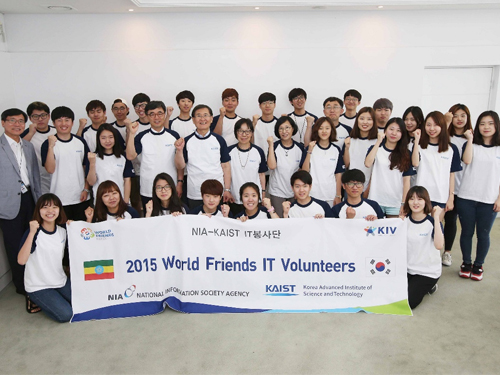 KAIST Undergraduate Students Volunteer in Ethiopia
World Friends (WF), one of the undergraduate student clubs at KAIST, offer students opportunities to volunteer in underdeveloped regions and countries. This year the World Friends team travels to Ethiopia from July 9 to August 17, 2015.
The aim of this trip is to help Ethiopian students fill gaps in their knowledge of information technology and encourage KAIST students build leadership skills through volunteer activities. Twenty-eight students will make the trip.
KAIST students will visit the Addis Ababa Institute of Technology and the Adama Science and Technology University, as well as some local high and elementary schools in Addis Ababa, where they will run computer classes related to the basics of information technology such as C Language, Java Programming, Photoshop, MS Office, and Windows.
The volunteers will offer Adama Science and Technology University students an advanced computer course to prepare them to participate in the ACM-ICPC, an international computer programming competition for university students.
KAIST students will also introduce Korean culture to Ethiopian students including K-pop, Korean cuisine and fashion, Korean language lessons, and traditional Korean art.
The Dean of Student Affairs and Policy at KAIST, Professor Young-Hee Kim said, “I hope the students from two very different cultures will cherish this opportunity to interact with each other and contribute to narrowing down the regional disparities in the IT field.”
2015.07.10 View 9320
KAIST Undergraduate Students Volunteer in Ethiopia
World Friends (WF), one of the undergraduate student clubs at KAIST, offer students opportunities to volunteer in underdeveloped regions and countries. This year the World Friends team travels to Ethiopia from July 9 to August 17, 2015.
The aim of this trip is to help Ethiopian students fill gaps in their knowledge of information technology and encourage KAIST students build leadership skills through volunteer activities. Twenty-eight students will make the trip.
KAIST students will visit the Addis Ababa Institute of Technology and the Adama Science and Technology University, as well as some local high and elementary schools in Addis Ababa, where they will run computer classes related to the basics of information technology such as C Language, Java Programming, Photoshop, MS Office, and Windows.
The volunteers will offer Adama Science and Technology University students an advanced computer course to prepare them to participate in the ACM-ICPC, an international computer programming competition for university students.
KAIST students will also introduce Korean culture to Ethiopian students including K-pop, Korean cuisine and fashion, Korean language lessons, and traditional Korean art.
The Dean of Student Affairs and Policy at KAIST, Professor Young-Hee Kim said, “I hope the students from two very different cultures will cherish this opportunity to interact with each other and contribute to narrowing down the regional disparities in the IT field.”
2015.07.10 View 9320 -
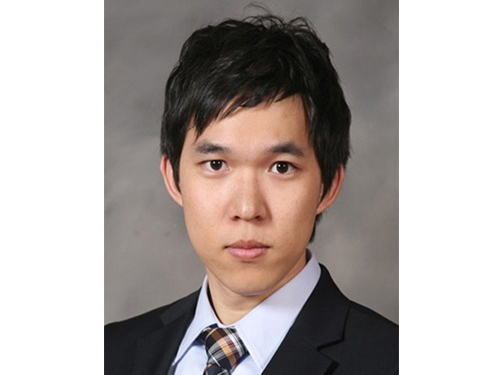 Dong-Young Lee, a Doctoral Candidate, Receives the Best Paper Award
Dong-Young Lee, a Ph.D. candidate in the Mechanical Engineering Department, KAIST, received the Best Paper Award at the 18th International Conference on Composite Structures (ICCS). The event was held in Lisbon, Portugal, on June 15-18, 2015. Mr. Lee’s adviser is Professor Dai-Gil Lee of the same department.
The ICCS is held every other year, and is one of the largest and long-established conferences on composite materials and structures in the world. At this year’s conference, a total of 680 papers were presented, among which, two papers were chosen for the Best Paper Award, including Mr. Lee’s.
The paper, entitled “Gasket-integrated Carbon and Silicon Elastomer Composite Bipolar Plate for High-temperature PEMFC,” will be published in the September issue of Composite Structures which is one of the top journals in mechanical engineering as judged by the Google Scholar Metrics rankings.
Mr. Lee dropped the conventional method of PEMFC (Proton Exchange Membrane Fuel Cells) assembly and instead developed a gasket-integrated carbon and silicone elastomer composite bipolar plate. This technology significantly increased the energy efficiency of fuel cells and their productivity.
Mr. Lee said, “I would like to thank the many people who supported me, especially my Ph.D. adviser, Professor Dai-Gil Lee. Without their encouragement, I would have not won this award. I hope my research will contribute to solving energy problems in the future.”
In addition, Professor Joon-Woo Im from Chonbuk National University, Senior Researcher Il-Bum Choi from the Agency for Defense Development, and a fellow doctoral candidate Soo-Hyun Nam from KAIST participated in this research project.
2015.07.09 View 11359
Dong-Young Lee, a Doctoral Candidate, Receives the Best Paper Award
Dong-Young Lee, a Ph.D. candidate in the Mechanical Engineering Department, KAIST, received the Best Paper Award at the 18th International Conference on Composite Structures (ICCS). The event was held in Lisbon, Portugal, on June 15-18, 2015. Mr. Lee’s adviser is Professor Dai-Gil Lee of the same department.
The ICCS is held every other year, and is one of the largest and long-established conferences on composite materials and structures in the world. At this year’s conference, a total of 680 papers were presented, among which, two papers were chosen for the Best Paper Award, including Mr. Lee’s.
The paper, entitled “Gasket-integrated Carbon and Silicon Elastomer Composite Bipolar Plate for High-temperature PEMFC,” will be published in the September issue of Composite Structures which is one of the top journals in mechanical engineering as judged by the Google Scholar Metrics rankings.
Mr. Lee dropped the conventional method of PEMFC (Proton Exchange Membrane Fuel Cells) assembly and instead developed a gasket-integrated carbon and silicone elastomer composite bipolar plate. This technology significantly increased the energy efficiency of fuel cells and their productivity.
Mr. Lee said, “I would like to thank the many people who supported me, especially my Ph.D. adviser, Professor Dai-Gil Lee. Without their encouragement, I would have not won this award. I hope my research will contribute to solving energy problems in the future.”
In addition, Professor Joon-Woo Im from Chonbuk National University, Senior Researcher Il-Bum Choi from the Agency for Defense Development, and a fellow doctoral candidate Soo-Hyun Nam from KAIST participated in this research project.
2015.07.09 View 11359 -
 Omnidirectional Free Space Wireless Charging Developed
The simultaneous charging of multiple mobile devices at 0.5 meter away from the power source is now possible under the international electromagnetic field guidelines.
Mobile devices, such as smartphones and laptops, have become indispensable portable items in modern life, but one big challenge remains to fully enjoying these devices: keeping their batteries charged.
A group of researchers at KAIST has developed a wireless-power transfer (WPT) technology that allows mobile devices to be charged at any location and in any direction, even if the devices are away from the power source, just as Wi-Fi works for Internet connections. With this technology, so long as mobile users stay in a designated area where the charging is available, e.g., the Wi-Power zone, the device, without being tethered to a charger, will pick up power automatically, as needed.
The research team led by Professor Chun T. Rim of the Nuclear and Quantum Engineering Department at KAIST has made great strides in WPT development. Their WPT system is capable of charging multiple mobile devices concurrently and with unprecedented freedom in any direction, even while holding the devices in midair or a half meter away from the power source, which is a transmitter. The research result was published in the June 2015 on-line issue of IEEE Transactions on Power Electronics, which is entitled “Six Degrees of Freedom Mobile Inductive Power Transfer by Crossed Dipole Tx (Transmitter) and Rx (Receiver) Coils.”
Professor Rim’s team has successfully showcased the technology on July 7, 2015 at a lab on KAIST’s campus. They used high-frequency magnetic materials in a dipole coil structure to build a thin, flat transmitter (Tx) system shaped in a rectangle with a size of 1m2. Either 30 smartphones with a power capacity of one watt each or 5 laptops with 2.4 watts each can be simultaneously and wirelessly charged at a 50 cm distance from the transmitter with six degrees of freedom, regardless of the devices’ three-axes positions and directions. This means that the device can receive power all around the transmitter in three-dimensional space. The maximum power transfer efficiency for the laptops was 34%. The researchers said that to fabricate plane Tx and Rx coils with the six-degree-of-freedom characteristic was a bottleneck of WPT for mobile applications.
Dipole Coil Resonance System (DCRS)
The research team used the Dipole Coil Resonance System (DCRS) to induce magnetic fields, which was developed by the team in 2014 for inductive power transfer over an extended distance. The DCRS is composed of two (transmitting and receiving) magnetic dipole coils, placed in parallel, with each coil having a ferrite core and connected with a resonant capacitor. Comparing to a conventional loop coil, the dipole coil is very compact and has a less dimension. Therefore, a crossed dipole structure has 2-dimension rather than 3-dimension of a crossed loop coil structure. The DCRS has a great advantage to transfer power even when the resonance frequency changes in the range of 1% (Q factor is below 100). The ferrite cores are optimally designed to reduce the core volume by half, and their ability to transfer power is nearly unaffected by human bodies or surrounding metal objects, making DCRS ideal to transmit wireless power in emergency situations. In a test conducted in 2014, Professor Rim succeeded in transferring 209 watts of power wirelessly to the distance of five meters. (See KAIST’s press release on DCRS for details: http://www.eurekalert.org/pub_releases/2014-04/tkai-wpt041714.php.)
Greater Flexibility and Safer Charging
The research team rearranged the two dipole coils from a parallel position to cross them in order to generate rotating magnetic fields, which was embedded in the Tx’s flat platform. This has made it possible for mobile devices to receive power from any direction.
Although wireless-power technology has been applied to smartphones, it could not offer any substantial advantages over traditional wired charging because the devices still require close contact with the transmitter, a charging pad. To use the devices freely and safely, including in public spaces, the WPT technology should provide mobile users with six degrees of freedom at a distance. Until now, all wireless-charging technologies have had difficulties with the problem of short charging distance, mostly less than 10 cm, as well as charging conditions that the devices should be placed in a fixed position. For example, the Galaxy S6 could only be charged wirelessly in a fixed position, having one degree of freedom. The degree of freedom represents mobile devices’ freedom of movement in three-dimensional space.
In addition, the DCRS works at a low magnetic field environment. Based on the magnetic flux shielding technology developed by the research team, the level of magnetic flux is below the safety level of the International Commission on Non-Ionizing Radiation Protection (ICNIRP) guideline (27µT) for general public exposure to electromagnetic field (EMF).
Professor Rim said, “Our transmitter system is safe for humans and compatible with other electronic devices. We have solved three major issues of short charging distance, the dependence on charging directions, and plane coil structures of both Tx and Rx, which have blocked the commercialization of WPT.”
Currently, the research team and KAIST’s spin-off company, TESLAS, Inc., have been conducting pilot projects to apply DCRS in various places such as cafes and offices.
YouTube Link: https://www.youtube.com/watch?v=JU64pMyJioc
Demonstration of 30 Watts Range Omnidirectional Wireless-charging at a Laboratory on KAIST’s Campus
Figure 1: Wide-range omnidirectional wireless-charging system based on DCRS can charge multiple numbers of mobile devices simultaneously in a 1m3 range. The above is a transmitter, and the below is a Samsung Galaxy Note with a receiver embedded inside.
Figure 2: Demonstration of the omnidirectional wireless-charging system (clockwise from top of the left, robust charging despite the presence of metal obstacles, omnidirectional charging, long distance charging, and multiple devices charging)
2015.07.08 View 17590
Omnidirectional Free Space Wireless Charging Developed
The simultaneous charging of multiple mobile devices at 0.5 meter away from the power source is now possible under the international electromagnetic field guidelines.
Mobile devices, such as smartphones and laptops, have become indispensable portable items in modern life, but one big challenge remains to fully enjoying these devices: keeping their batteries charged.
A group of researchers at KAIST has developed a wireless-power transfer (WPT) technology that allows mobile devices to be charged at any location and in any direction, even if the devices are away from the power source, just as Wi-Fi works for Internet connections. With this technology, so long as mobile users stay in a designated area where the charging is available, e.g., the Wi-Power zone, the device, without being tethered to a charger, will pick up power automatically, as needed.
The research team led by Professor Chun T. Rim of the Nuclear and Quantum Engineering Department at KAIST has made great strides in WPT development. Their WPT system is capable of charging multiple mobile devices concurrently and with unprecedented freedom in any direction, even while holding the devices in midair or a half meter away from the power source, which is a transmitter. The research result was published in the June 2015 on-line issue of IEEE Transactions on Power Electronics, which is entitled “Six Degrees of Freedom Mobile Inductive Power Transfer by Crossed Dipole Tx (Transmitter) and Rx (Receiver) Coils.”
Professor Rim’s team has successfully showcased the technology on July 7, 2015 at a lab on KAIST’s campus. They used high-frequency magnetic materials in a dipole coil structure to build a thin, flat transmitter (Tx) system shaped in a rectangle with a size of 1m2. Either 30 smartphones with a power capacity of one watt each or 5 laptops with 2.4 watts each can be simultaneously and wirelessly charged at a 50 cm distance from the transmitter with six degrees of freedom, regardless of the devices’ three-axes positions and directions. This means that the device can receive power all around the transmitter in three-dimensional space. The maximum power transfer efficiency for the laptops was 34%. The researchers said that to fabricate plane Tx and Rx coils with the six-degree-of-freedom characteristic was a bottleneck of WPT for mobile applications.
Dipole Coil Resonance System (DCRS)
The research team used the Dipole Coil Resonance System (DCRS) to induce magnetic fields, which was developed by the team in 2014 for inductive power transfer over an extended distance. The DCRS is composed of two (transmitting and receiving) magnetic dipole coils, placed in parallel, with each coil having a ferrite core and connected with a resonant capacitor. Comparing to a conventional loop coil, the dipole coil is very compact and has a less dimension. Therefore, a crossed dipole structure has 2-dimension rather than 3-dimension of a crossed loop coil structure. The DCRS has a great advantage to transfer power even when the resonance frequency changes in the range of 1% (Q factor is below 100). The ferrite cores are optimally designed to reduce the core volume by half, and their ability to transfer power is nearly unaffected by human bodies or surrounding metal objects, making DCRS ideal to transmit wireless power in emergency situations. In a test conducted in 2014, Professor Rim succeeded in transferring 209 watts of power wirelessly to the distance of five meters. (See KAIST’s press release on DCRS for details: http://www.eurekalert.org/pub_releases/2014-04/tkai-wpt041714.php.)
Greater Flexibility and Safer Charging
The research team rearranged the two dipole coils from a parallel position to cross them in order to generate rotating magnetic fields, which was embedded in the Tx’s flat platform. This has made it possible for mobile devices to receive power from any direction.
Although wireless-power technology has been applied to smartphones, it could not offer any substantial advantages over traditional wired charging because the devices still require close contact with the transmitter, a charging pad. To use the devices freely and safely, including in public spaces, the WPT technology should provide mobile users with six degrees of freedom at a distance. Until now, all wireless-charging technologies have had difficulties with the problem of short charging distance, mostly less than 10 cm, as well as charging conditions that the devices should be placed in a fixed position. For example, the Galaxy S6 could only be charged wirelessly in a fixed position, having one degree of freedom. The degree of freedom represents mobile devices’ freedom of movement in three-dimensional space.
In addition, the DCRS works at a low magnetic field environment. Based on the magnetic flux shielding technology developed by the research team, the level of magnetic flux is below the safety level of the International Commission on Non-Ionizing Radiation Protection (ICNIRP) guideline (27µT) for general public exposure to electromagnetic field (EMF).
Professor Rim said, “Our transmitter system is safe for humans and compatible with other electronic devices. We have solved three major issues of short charging distance, the dependence on charging directions, and plane coil structures of both Tx and Rx, which have blocked the commercialization of WPT.”
Currently, the research team and KAIST’s spin-off company, TESLAS, Inc., have been conducting pilot projects to apply DCRS in various places such as cafes and offices.
YouTube Link: https://www.youtube.com/watch?v=JU64pMyJioc
Demonstration of 30 Watts Range Omnidirectional Wireless-charging at a Laboratory on KAIST’s Campus
Figure 1: Wide-range omnidirectional wireless-charging system based on DCRS can charge multiple numbers of mobile devices simultaneously in a 1m3 range. The above is a transmitter, and the below is a Samsung Galaxy Note with a receiver embedded inside.
Figure 2: Demonstration of the omnidirectional wireless-charging system (clockwise from top of the left, robust charging despite the presence of metal obstacles, omnidirectional charging, long distance charging, and multiple devices charging)
2015.07.08 View 17590 -
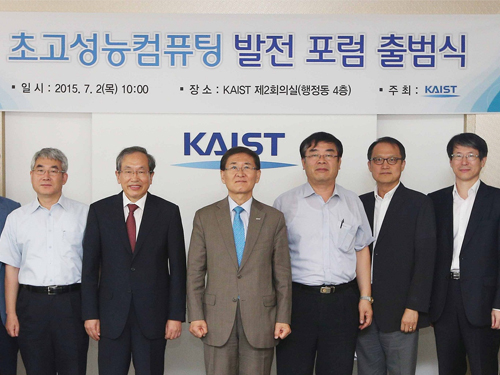 Experts Gather to Develop a Korean Supercomputer on KAIST Campus
KAIST hosted an inauguration ceremony for the Super-Capacity Computing Advancement Forum on July 2, 2015, to increase Korea's national computing capacity. It represents a gathering consisting of experts drawn across industry, university, and institutes in super-capacity computing.
More than ten experts from the university, including President Steve Kang and Professor Oh-Joon Kwon of the Department of Aerospace Engineering, attended the ceremony. This forum was created to secure a competitive edge in the global market by establishing a long-term strategy for the development of super computers.
The recent rise of new service industries, such as voice recognition, artificial intelligence, and the Internet of Things, has increased the need for super-capacity computing to deal more rapidly with big data. The need is made more urgent by increased investment by leading countries in this field.
The forum will organize and operate working-level subcommittees to promote in-depth discussions on issues related to super-capacity computing systems. Open forums and public hearings will be held until October, to gather information and insights needed to advance the field.
President Steve Kang, the Chairman of the Forum, said, “The forum will have a great impact on Korea’s effort to become a world leader in super-capacity computing. We plan to debate the pros and cons of potential solutions to the Korean government, to assist them in building the nation’s competitiveness in super-capacity computing capability.”
2015.07.07 View 7407
Experts Gather to Develop a Korean Supercomputer on KAIST Campus
KAIST hosted an inauguration ceremony for the Super-Capacity Computing Advancement Forum on July 2, 2015, to increase Korea's national computing capacity. It represents a gathering consisting of experts drawn across industry, university, and institutes in super-capacity computing.
More than ten experts from the university, including President Steve Kang and Professor Oh-Joon Kwon of the Department of Aerospace Engineering, attended the ceremony. This forum was created to secure a competitive edge in the global market by establishing a long-term strategy for the development of super computers.
The recent rise of new service industries, such as voice recognition, artificial intelligence, and the Internet of Things, has increased the need for super-capacity computing to deal more rapidly with big data. The need is made more urgent by increased investment by leading countries in this field.
The forum will organize and operate working-level subcommittees to promote in-depth discussions on issues related to super-capacity computing systems. Open forums and public hearings will be held until October, to gather information and insights needed to advance the field.
President Steve Kang, the Chairman of the Forum, said, “The forum will have a great impact on Korea’s effort to become a world leader in super-capacity computing. We plan to debate the pros and cons of potential solutions to the Korean government, to assist them in building the nation’s competitiveness in super-capacity computing capability.”
2015.07.07 View 7407 -
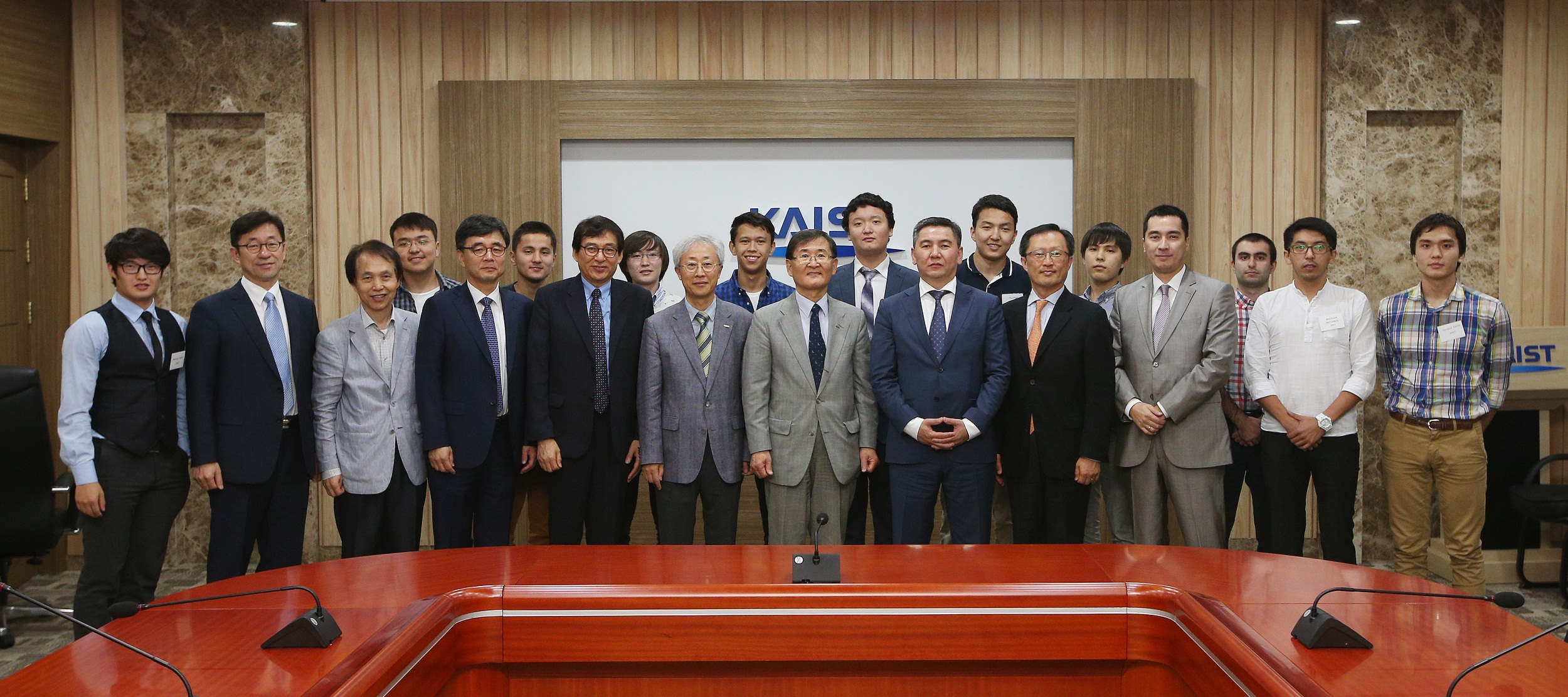 The Minister of Education of Kazakhstan Visits KAIST
The Minister of Education of the Republic of Kazakhstan, Aslan Sarinzhipov, and his delegation visited KAIST on June 30, 2015.
Dr. Young-Suk Ji, the Chairman of Elsevier, an academic publishing company that publishes medical and scientific literature, arranged the visit.
The Kazakh delegation showed great interest in KAIST’s educational system and research programs during their meeting with President Steve Kang of KAIST. In particular, the delegation was most impressed by the startups and entrepreneurship programs established at the KAIST Pangyo Innovation Center.
President Kang said, “I hope the Minister’s visit will help inspire more Kazakh students to come to Korea and study at KAIST.”
Kazakhstan, located in the northern part of Central Asia, gained its independence in 1991 after the collapse of the Soviet Union. Currently, there are 22 Kazakh students studying at KAIST.
2015.07.03 View 5693
The Minister of Education of Kazakhstan Visits KAIST
The Minister of Education of the Republic of Kazakhstan, Aslan Sarinzhipov, and his delegation visited KAIST on June 30, 2015.
Dr. Young-Suk Ji, the Chairman of Elsevier, an academic publishing company that publishes medical and scientific literature, arranged the visit.
The Kazakh delegation showed great interest in KAIST’s educational system and research programs during their meeting with President Steve Kang of KAIST. In particular, the delegation was most impressed by the startups and entrepreneurship programs established at the KAIST Pangyo Innovation Center.
President Kang said, “I hope the Minister’s visit will help inspire more Kazakh students to come to Korea and study at KAIST.”
Kazakhstan, located in the northern part of Central Asia, gained its independence in 1991 after the collapse of the Soviet Union. Currently, there are 22 Kazakh students studying at KAIST.
2015.07.03 View 5693